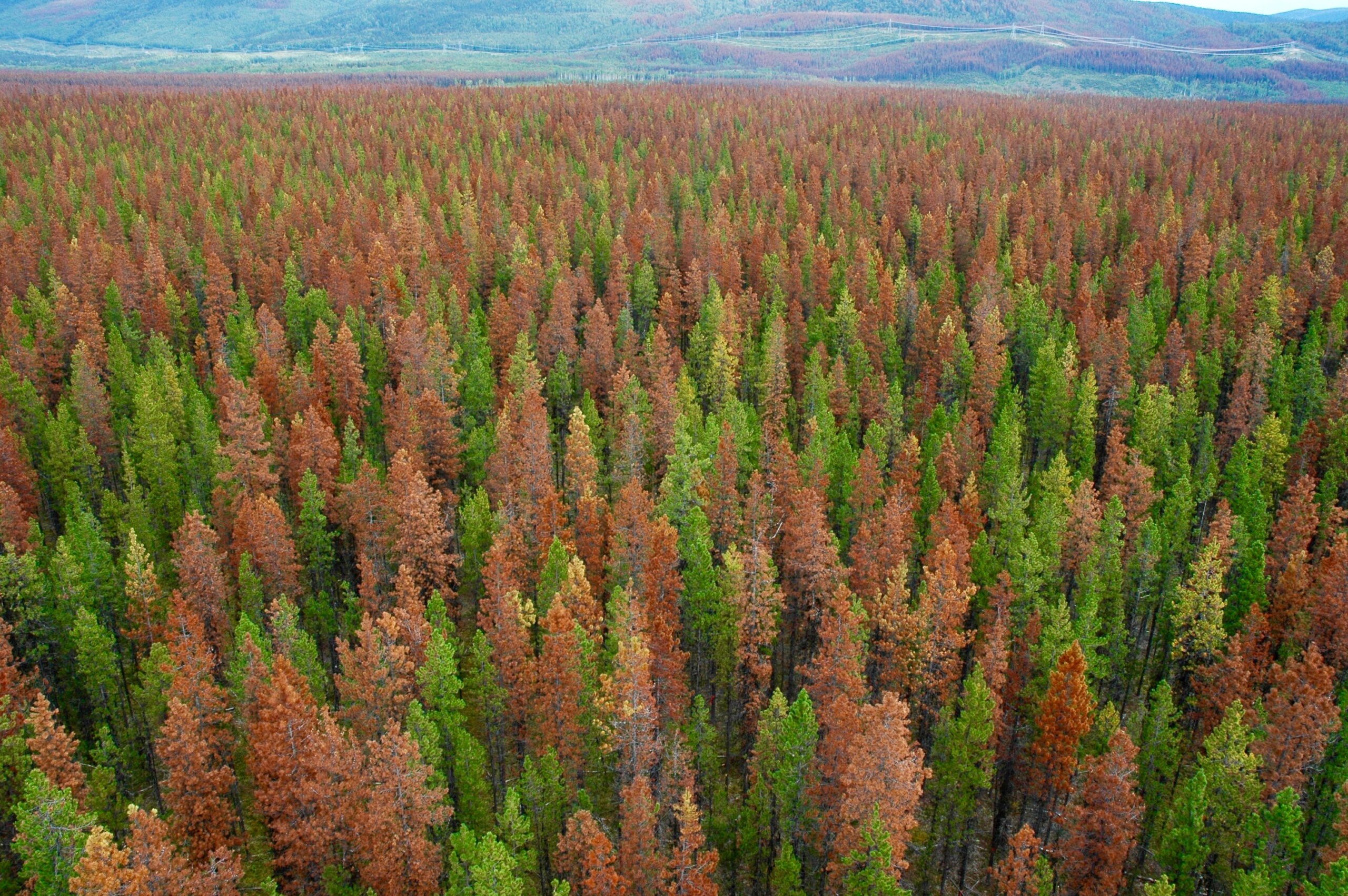Climate Change in British Columbia’s Forest Sector
Natasha Escobedo
Introduction
In this short commentary, we will explore the consequences climate change has posed on the forested ecosystems and how that impacts the forest sector of British Columbia. The assessment serves to aid in determining the best solution to the climate change crisis.
British Columbia’s Forest Sector
In terms of global climate change mitigation, forests contribute largely to carbon sequestration in the form of carbon sinks (Xu et al., 2018), aiding in the reduction of greenhouse gas (GHG) emissions (Lemprière et al., 2017). Forested areas across the globe that are not affected by land use change can remove up to 8.8 GtC02/year (Xu et al., 2018) from the atmosphere, while it is predicted that the British Columbian forest sector has the potential to remove between 0.2-13.8 GtC02/year by 2030 (Xu et al., 2018). British Columbia’s forests account for 55 million hectares, where 95% are provincially owned (Xu et al., 2018).
Mountain Pine Beetle & Wildfires

Since the early 2000s, British Columbia’s forest sector has seen some devastating events that impacted the production and harvesting of timber (Corbett et al., 2015). Climate change has triggered, through cause and effect, irreversible damage to the forest sector through events such as the Mountain Pine beetle (MPB) epidemic, which devastated approximately 18.3 million hectares of forested ecosystems, causing a $57 billion cumulative loss in GDP in B.C. (Corbett et al., 2015).
Wildfires in recent years have been extremely devastating in terms of forested ecosystem damage, where the damages each year seem to be greater than the last and are predicted to increase in future years. With this, cumulatively, wildfire has devastated 7.7 million hectares of forested and residential land in B.C. since 2008 (BC Wildfire Service, 2024). Due to the insurmountable damage caused, the economic impact is approximately $17 billion cumulative loss in GDP; however, this is an approximation as limited data is available (see Table 1) (BC Wildfire Service, 2024).
Globally, forests are extremely important to the carbon cycle as long-term storage and the largest terrestrial sinks for CO2 (North & Hurteau, 2011). Climate change has altered the frequency and severity of natural disturbances, resulting in increased release of stored carbon within the B.C. forest sector. This increased release of CO2 has been recorded through the MPB epidemic, which is responsible for 270 megatons of stored CO2 released, and through the wildfire seasons, which released approximately 46 megatons of stored carbon within the past 20 years alone (see Table 1).
Table 1: Economic Impacts of Climate Change on B.C. Forest Sector
| Skip Table 1 | |||
| Climate Change Damaging Agent | Damage (ha) | Average C Released (20-year period) | Cumulative Economic Impact ($ loss 2000–2023) |
|---|---|---|---|
| Pine Beetle Epidemic | 18,300,000 | 270 Mt | $57.37 billion GDP $90 billion welfare |
| Wildfire | 7,761,742 | 46 Mt | $17.1 (approx.) billion GDP |
Note. Data from Corbett et al., (2015) and BC Wildfire Service (2024)
SSC of Damages
Carbon sequestration from the atmosphere is an important part of reaching carbon targets (Smyth et al., 2020); however, climate change is making these goals harder to reach due to the ongoing impacts of climate change, causing these mass devastating events that release insurmountable amounts of carbon into the atmosphere and damaging these carbon sinks (Kirilenko & Sedijo, 2007). Estimations of the social costs of carbon (SCC) are crucial for developing climate policies (Pindyck, 2019). With the insurmountable damage seen in B.C.’s Forest sector by the mountain pine beetle epidemic and the wildfire activity, the estimated SCC can be used to help determine the right policies to implement.
Table 2 shows the SCC for the cumulative impacts of wildfires and the MPB epidemic.
Table 2: Climate Change Damages Using Social Costs of Carbon (SCC)
| Skip Table 2 | |||
| Social Cost of Carbon ($/Mt) | SCC per ton | Total SCC of Wildfires | Total SSC of Pine Beetle Epidemic |
|---|---|---|---|
| Economics | 173.7 | $8 billion | $46.9 billion |
| Climate Change | 316.3 | $14.6 billion | $85.4 billion |
| Conservative | 100.0 | $2.7 billion | $27.0 billion |
Note. Data from Pindyck (2019), Corbett at al. (2015), and BC Wildfire Service (2024)
Media Attribution
Figure 1: “Kennedy Siding – Attacked Canopy in 2007” by Matthew Brown and UBC Micrometeorology (2007), via Flickr, is used under a CC BY 2.0 license.
References
BC Wildfire Service. (2024, April 26). Wildfire averages. Government of British Columbia. https://www2.gov.bc.ca/gov/content/safety/wildfire-status/about-bcws/wildfire-statistics/wildfire-averages.
Brown, M. & UBC Micrometeorology. (2007). Kennedy Siding – attacked canopy in 2007 [Image]. Flickr. https://www.flickr.com/photos/140969380@N07/28371273392.
Corbett, L. J., Withey, P., Lantz, V. A., & Ochuodho, T. O. (2015). The economic impact of the mountain pine beetle infestation in British Columbia: provincial estimates from a CGE analysis. Forestry: An International Journal of Forest Research, 89(1), 100–105. https://doi.org/10.1093/forestry/cpv042.
Kirilenko, A. P., & Sedjo, R. A. (2007). Climate change impacts on forestry. Proceedings of the National Academy of Sciences, 104(50), 19697–19702. https://doi.org/10.1073/pnas.0701424104.
Lemprière, T. C., Krcmar, E., Rampley, G. J., Beatch, A., Smyth, C. E., Hafer, M., & Kurz, W. A. (2017). Cost of climate change mitigation in Canada’s forest sector. Canadian Journal of Forest Research, 47(5), 604–614. https://doi.org/10.1139/cjfr-2016-0348.
North, M. P., & Hurteau, M. D. (2011). High-severity wildfire effects on carbon stocks and emissions in fuels treated and untreated forest. Forest Ecology and Management, 261(6), 1115–1120. https://doi.org/10.1016/j.foreco.2010.12.039.
Pindyck, R. S. (2019). The social cost of carbon revisited. Journal of Environmental Economics and Management, 94, 140–160. https://doi.org/10.1016/j.jeem.2019.02.003.
Smyth, C. E., Xu, Z., Lempriere, T. C, & Kurz, W. A. (2020). Climate change mitigation in British Columbia’s forest sector: GHG reductions, costs, and environmental impacts. Carbon Balance and Management, 15, Article 21. https://doi.org/10.1186/s13021-020-00155-2.
Xu, Z., Smyth, C. E., Lempriere, T. C., Rampley, G. J., & Kurz, W. A. (2018). Climate change mitigation strategies in the forest sector: Biophysical impacts and economic implications in British Columbia, Canada. Mitigation and Adaptation Strategies for Global Change, 23, 257–290. https://doi.org/10.1007/s11027-016-9735-7.

